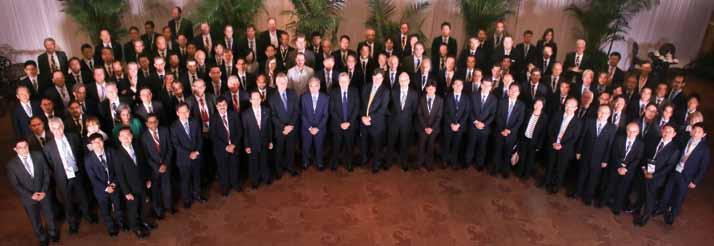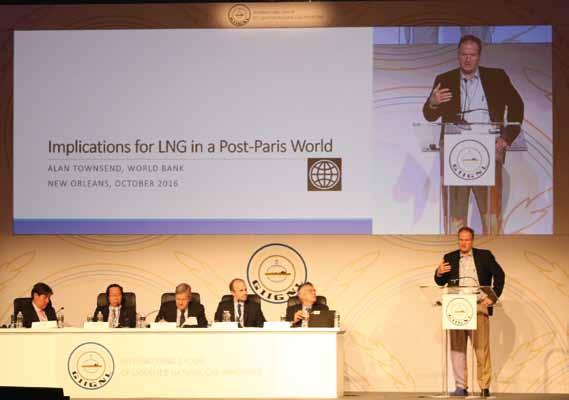
13 minute read
News from organisations affiliated to IGU
by IGU
This issue we have news on developments from the Gas Technology Institute (GTI) which recently celebrated 75 years of operation. They highlight some of their latest projects and initiatives from all points along the gas value chain. The International Group of Liquefied Natural Gas Importers (GIIGNL) reports on its General Assembly which was held in New Orleans in October last year. And finally we have an overview of the World LPG Association’s new Exceptional Energy in Action website, a highly comprehensive database of information about LPG and its applications across all sectors of society.
GTI continues to build on 75-year legacy of technical innovations and market impact
By Diane Miller For more than seven decades, Gas Technology Institute scientists and engineers have developed high-impact technologies and provided technical insights to unlock the potential of natural gas and other energy resources, helping make them economically and environmentally sustainable, while reducing costs for consumers.
Looking back over 75 years of accomplishments, Illinois-based GTI has achieved an impressive record of success in improving the ways energy is produced, transported and used around the world. These contributions are the foundation of GTI’s reputation as a trusted partner to industry and government.
Looking to the future, society needs innovative solutions to deliver the affordable and reliable energy that is critical for developing nations currently dealing with population growth, urbanisation and poor air quality. Natural gas, coupled with the many technologies under development at GTI and elsewhere, will help ensure that expanding global energy needs will be met responsibly and safely for decades to come.
Efficient and sustainable production of shale gas
Shale gas is one of America’s premier examples of joint government and industry R&D yielding tremendous cost/benefit ratios and long-term, transformational societal value. After 30 years of research and field experiments conducted by the Department of Energy (DOE), GTI and the private sector, the ‘shale revolution’ emerged during the recent recession, providing a securely accessible, low-cost energy resource for the 21st century while supporting the country’s economic resurgence with millions of industry jobs and billions in annual economic value. Innovations in reservoir mapping, hydraulic fracturing and horizontal drilling coupled with favourable tax policies unlocked a national treasury of unconventional oil and natural gas.
With recovery of shale hydrocarbons in place under 20%, the US industry has just scratched

the surface of its tremendous potential. GTI continues its leadership in unconventional oil and gas solutions through the Hydraulic Fracturing Test Site (HFTS) programme, a public-private partnership that addresses challenges to sustainable long-term development. The initial test site in Texas included more than $22m of funding from the US Department of Energy National Energy Technology Laboratory (DOE/NETL) and numerous operators and service companies. The programme, targeting horizontal shale wells, has already delivered a one-of-a-kind through-fracture core sample that shows the physical properties of the fractures for observation. Along with comprehensive data, it illustrates how induced underground fractures spread and will fundamentally alter the understanding of hydraulic fracture propagation, modelling and effectiveness.
The goal of these efforts is to optimise required well spacing and reduce the environmental impacts of responsible development. Future experiments are being planned and developed in other basins. In October 2016, GTI and BHP Billiton Petroleum (BHP) signed a letter of intent for HFTS No. 2 in the Delaware Basin. Such programmes have the potential to reduce by thousands the number of wells required to sustain environmentally prudent resource production.
Midstream methane-emissions measurement and mitigation
The US natural gas infrastructure is a robust, flexible and reliable delivery system. While natural gas has lower carbon emissions than some other energy resources, methane detection and leakage must be addressed to fully realise its environmental benefits and expand its usage.
GTI is developing technologies to provide remote monitoring of natural gas pipeline conditions and early detection of factors leading to a potential for unintended methane release. To reduce methane emissions, GTI is developing an integrated thermoelectric generator/burner system for oil and gas field operations to eliminate natural gas use as the operating fluid for pneumatic controllers (a significant upstream source of methane emissions). Other mitigation measures are needed, including alternatives to casing repair materials, techniques for capturing methane at natural gas transmission compressor stations and gas processing facilities, and demonstration of mitigation technologies under development.
Clean and efficient power applications
GTI, with partners Southwest Research Institute (SwRI) and GE Global Research, will conduct a $110m DOE/NETL project to design, build and operate a 10 MWe (megawatts electrical) pilot plant to develop power systems using supercritical carbon dioxide (sCO 2 ) fluid. This project will integrate and prove compact, modular technologies that can be applied to generate power from natural gas, coal, next-generation nuclear, solar and industrial waste heat recovery and offer a stepchange increase in efficiency and corresponding reduction in emissions.
c The Hydraulic Fracturing
Test Site No. 1, hosted by Laredo Petroleum in a Permian basin field in west Texas.
v In proof-of-concept
testing GTI’s new gas-fired heat pump water heater has shown a significant improvement over standard models.
x GIIGNL Members
gathered in New Orleans, Louisiana.

Residential and commercial gas equipment efficiency
GTI has a long legacy of promoting the clean and efficient use of energy resources in residential and commercial end-use markets. Our experts have made significant contributions to codes and standards issues and we have developed factual scientific data regarding the benefits of source energy to support energy efficiency standards. Assessments to verify equipment durability and performance have increased product adoption by providing potential customers with the knowledge and confidence to buy. Residential and commercial appliance innovations have led the way in

reducing energy consumption and environmental footprint.
Partnering with Stone Mountain Technologies and AO Smith, GTI designed and demonstrated a novel ultra-high-efficiency gas-fired heat pump water heater through laboratory proof-ofconcept testing. The system meets NO X requirements and has an energy factor that is more than twice that of standard gas water heaters.
Utilization Technology Development
Established in early 2004, Utilization Technology Development (UTD) helps utilities build technology portfolios and expand efficiency programmes. UTD secured its first European member in 2015. Gas Natural Fenosa is headquartered in Spain and has utility operations in multiple countries, including Mexico. Led by 17 member companies, UTD represents over 37 million natural gas customers in the Americas and Europe.
Diane Miller is Senior Marketing Communications Manager at the Gas Technology Institute (www.gastechnology.org).
GIIGNL’s General Assembly, New Orleans
By Vincent Demoury Last year saw the export of the first LNG cargo from continental USA in over 50 years. This was a momentous occasion for the industry and for
z From left to right:
Domenico Dispenza, Jean-Marie Dauger and Tsuyoshi Okamoto, Executive Vice President, Tokyo Gas Co Ltd.
v Jason Bordoff of
Columbia University addressed the impact of US LNG exports on the global LNG market.

LNG importers who gathered in October in Louisiana, the state where the Sabine Pass liquefaction facility is located.
The annual General Assembly meeting of GIIGNL was held on October 17 and 18, 2016 in New Orleans, at the kind invitation of Cheniere Energy.
Around 150 senior representatives from 78 GIIGNL member companies and 25 countries met to exchange views and to receive updates on the latest commercial and technical developments of the LNG industry.
Three new member firms from three different regions joined the association and attended the meeting for the first time: ENN LNG Trading, Gazprom Marketing & Trading and Excelerate Energy.
On October 17, Jack Fusco, CEO of Cheniere Energy welcomed participants and expressed his strong belief in the future growth of LNG, predicting a spectacular shift to cleaner-burning natural gas for power generation worldwide, for economic as well as environmental reasons.
The opening presentation from Giorgio Bresciani, Senior Partner and Director of the Global Gas practice at McKinsey, examined the promising role of natural gas and LNG in the context of the energy transition. He highlighted the current market features and pointed out the necessity of cooperating along the value


v Alan Townsend from
the World Bank on “Implications for LNG in a Post-Paris World”.
chain in order to address the upcoming challenges to be faced by buyers and sellers.
As a complement to a series of regional market overviews, Gordon Exel, Chairman of NGVAmerica (Natural Gas Vehicles for America), presented the opportunities and challenges for LNG as a fuel for trucks.
On the afternoon of October 17, GIIGNL members elected Jean-Marie Dauger as President, succeeding Domenico Dispenza. A new Executive Committee was formed, composed of three regional Vice Presidents and of 12 Executive Committee members also representing the three regions: Asia, Americas and Europe.
The first day of the meeting ended up with an outstanding gala evening during which delegates had a chance to listen to a highly talented New Orleans jazz music band.
On the second day of the gathering, Jason Bordoff, Professor at Columbia School of International and Public Affairs, discussed the economic and geopolitical impact of US exports on the global LNG market. He gave the audience his views on the price competitiveness of US LNG in the medium to long term, considering the uncertainties weighing on global LNG supply and demand. A former advisor to the White House, Bordoff also provided some rare insight on US energy policy and on American public opinion with regard to climate change issues.
Later on the second day, Alan Townsend, Senior Director Energy, World Bank, reviewed the implications for LNG in a post-Paris world. According to him, one of the main challenges is the fact that new gas infrastructure will be required in the future while volumes that are needed will be difficult to predict, in part due to the fact that COP 21 targets will be met on a non-mandatory basis. Townsend explained that the World Bank supports the growth of natural gas and the slowdown of coal plants, specifically targeting South and Southeast Asian countries (mainly Indonesia, India, Pakistan, Philippines and Vietnam) in order to promote a

combination of energy efficiency, renewables and natural gas.
Finally, Nikos Tsafos, CEO of Washington DC-based energy consulting firm Enalytica addressed the role of gas in the energy transition by questioning traditional assumptions related to energy and gas: will energy demand really keep growing? Will transition to new energies be slow? Will gas gain in a carbon-constrained world?
His conclusions - quite similar to Townsend's findings, but slightly more pessimistic - showed that although there is a general consensus that gas should gain market share because it is cleaner and can complement intermittent renewable energy, the truth is somewhat more complex. In many parts of the world, the market share of natural gas has peaked and it appears that gas can be a good complement to renewables only in the context of good policy. In this uncertain environment, Tsafos invited energy companies to rethink their ways of responding to energy demand, emphasising the fact that customers do not value the commodity itself but rather the potential benefits associated with it.
In the afternoon of October 18, the participants enjoyed a fascinating tour of New Orleans in a traditional streetcar from the 1920s, concluded by an exquisite private dinner at Brennan’s, one of the city’s most renowned Creole fine-dining landmarks.
Vincent Demoury is General Delegate, International Group of Liquefied Natural Gas Importers (www.giignl.org).
Enagás supports the diversity of supply in Europe

Enagás’ large experience as independent Transmission System Operator, TSO accredited by the EU, and leader in liquefi ed natural gas infrastuctures at the service of diversity of supply in Europe.
International leader in LNG infrastructures
v The Exceptional
Energy in Action website, www.lpg-apps.org, is a centralised database featuring news, case studies, and information on the whole range of LPG’s applications worldwide. WLPGA’s LPG applications database: exceptional energy in action
By Nikos Xydos The World LPG Association (WLPGA) is the authoritative voice of the global LPG industry, representing the full LPG value chain. The primary goal of the association is to add value to the sector by driving premium demand for LPG while also promoting compliance to good business and safety practices. WLPGA has a four-point mission and one of these four core goals is to identify innovation. WLPGA actively promotes technology and innovation and constantly seeks new technologies that will guide future opportunities.
LPG is used by hundreds of millions of people and for thousands of applications around the world. LPG is an exceptional energy source due to its origin, benefits, availability and the variety of applications that use it. As arguably the world’s most multi-purpose energy, LPG plays a pivotal role in the transition towards a more secure, sustainable and competitive energy model.
However, while the vast variety of applications that can use LPG as a fuel is one of the key advantages of LPG, some of the applications are little known to the wider public and sometimes even among parts of the LPG industry itself.
Recognising this, in 2014, WLPGA launched a dedicated online LPG applications directory. Called Exceptional Energy in Action (EEIA), the goal of the database is to list and promote, as far as possible, all known and existing applications and appliances of LPG.
The goal of EEIA is to raise awareness of the exceptional variety of applications and support the spread of new LPG applications and technologies. In addition, EEIA will promote the use and knowledge of LPG and its applications within the industry and beyond.
Now fully live, the EEIA website is continually developed and enhanced and is a valuable knowledge base on everything there is to know

about LPG applications. It includes a variety of supporting materials such as industry reports, case studies, videos, photos, etc, to complement the actual database. With EEIA, the industry now has, in one place, a comprehensive listing of how LPG can be used around the world.
With a comprehensive search tool, any information contained can be easily explored by market sector such as industrial, agricultural, commercial, etc, even down to a very specific subsector such as hotels, bakeries; or by function, as in heating, cooking, cleaning, power generation or simply by a direct search. In addition to the information contained on the various uses and

applications, EEIA features current news related to new LPG applications, appliances and products that are new to the market.
Topping the list of any Google LPG applications search, EEIA has become today the most comprehensive and authoritative database for LPG applications available. Produced and maintained by WLPGA, visit EEIA at www.lpg-apps.org and follow EEIA on Twitter at @LPGapps.
Nikos Xydas is WLPGA’s Technical Director. For more information, please contact him on nxydas@wlpga.org and discover the WLPGA at www.wlpga.org.

c With such a wealth
of information available, the comprehensive search functionality of the site allows visitors to drill down to the content relevant to their needs.
c More than a thousand










